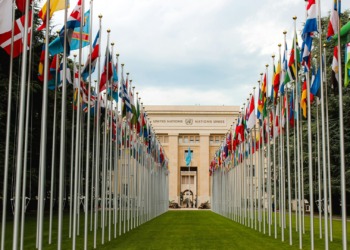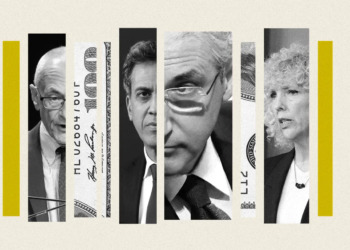The time to strategically and boldly invest in Syrian education is now. The 2017 Global Terrorism Index shows a notable shift in terror tactics. In 2009, 16% of Al Qa’ida attacks targeted educational facilities, but only 1.5% of attacks had this same focus in 2016. This not only prompts timely investment in positive peace, but an opportune centralisation of education in the discussion of nation-building. Syrian society faces a dire but not hopeless risk of losing a critical youthful generation to war. The war’s current duration parallels the expected length of a young person’s primary or secondary schooling career.
From 2011, Syria spiralled into a civil war. 12 million Syrians have been displaced, and over 4000 schools have been destroyed or abandoned. The first spark of the civil war was lit from the embers of the Arab Spring that showed promising outcomes for the verve of democracy in neighbouring Tunisia. The Syrian conflict originated from often peaceful protests and morphed into a cocktail of various terror organisations, prominent international interventions, the largest displacement crisis in the world, and a generation denied their right to education. According to Human Rights Watch, 91% of primary school aged children were in regulated education systems before the war, compared to only 37% in 2015. The war in Syria has derailed the nation’s applauded progress in regards to Goal 4 of the United Nations Sustainable Development Goals: Ensure inclusive and quality education for all and promote lifelong learning.
 In the photo: Syrian children playing in the school playground Credit: REUTERS/ Khali Ashawi
In the photo: Syrian children playing in the school playground Credit: REUTERS/ Khali Ashawi
Syria has been celebrated for its extensive history of learning and education. Home to the first known alphabets and to one of the oldest languages used today, Aramaic, Syria maintained one of the highest levels of education for its citizens in the Middle Eastern region. The language of instruction in Syrian schools is Arabic, although in 2005 English lessons were introduced for first grade students. In 2014 Russian was introduced as a second language for students to learn. The most recently available data on Gross Domestic Product expenditure in Syria comes from 2009 – showing a 5.1% allocation of the GDP to education. Comparatively, in the same year the United States of America allocated 3.6% of their GDP to education, and the United Kingdom allocated 4.3% of their GDP.
A year into the civil war, in 2012, only 57% of students continued on to secondary school. This figure is down from 98% the previous year, evidencing the immediately disruptive nature of the internal conflict.
Yet a unique window of opportunity has appeared. As a shift away from educational facility based attacks by Al Qa’ida’s Syrian branch, Jabhat Fateh al-Sham, is noted, and terrorist organisations lose their grip on Syria, there is an opportunity for peace to be defined not only be the absence of violence. Instead, peace in Syria can be characterised by the presence of attitudes, institutions, and structures that create and sustain a peaceful society. The 2017 Positive Peace Report notes high levels of human capital, as greatly influenced by resilient education, as a contributor to the maintenance of peace. Through education Syrians will be afforded sovereignty, optimistic prospects for democracy, and a peaceful state.
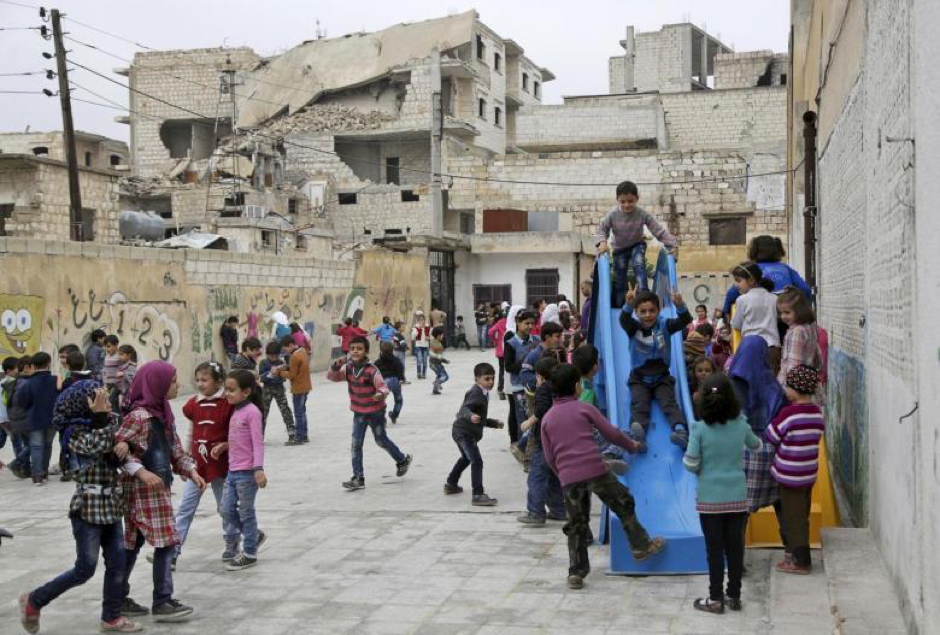
In the photo: School playground amongst destroyed buildings Credit: REUTERS/Khalil Ashawi
Accessible and resilient education is imperative to Syria’s recovery. Education is a deadly pursuit for Syrians internally displaced, and an often fruitless pursuit for Syrian refugees. But education is key to affording Syrian refugees the tools needed to contribute to their hosting countries economically and socially. Tutelage is also central to granting agency and knowledge to Syrians to reconstruct their own country as peace returns. Nation-rebuilding is becoming a tangible, instead of distant, aspiration as ISIL continues to lose territory in both Iraq and Syria. Further, the 2017 Global Terrorism Index reported the first reduction in deaths by terrorism in Syria since the war began. The vigour of knowledge and civic participation granted to Syrians through education is instrumental not only to nation building, but also to resisting the threat of radicalisation, thus abating the very crux of Syria’s current conflict.
The experiences of students in any form of education in Syria are patchy and varied. The Syrian government maintains official control of the educational system. By presidential decree in 2011, students in higher education are able to defer up to eight subjects to the following year, and can sit exams in an ad-hoc third trimester if they have failed throughout the year. The aim is to support students with unstable circumstances to pursue their studies. The majority of Syria is currently government-controlled. In these places, the educational environment is typically safer and more stable than other regions, thus being very attractive to students with mobility. Consequently, the classrooms are very overcrowded.
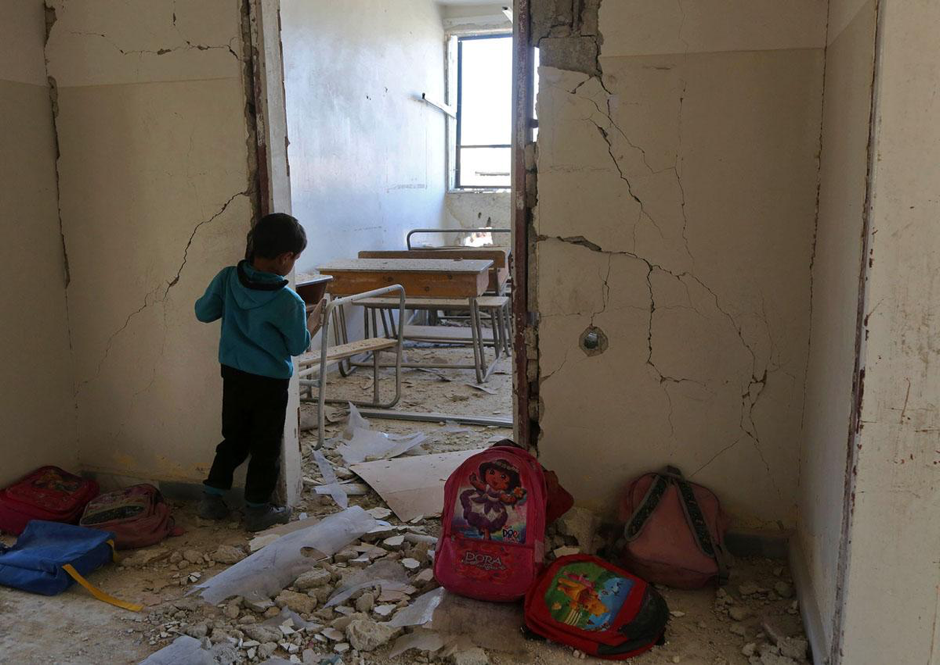
In the photo: Syrian classroom turned to rubble Credit: Amer Almohibany / AFP / Getty
In opposition-controlled areas of Syria, the semesters for education are intermittent due to armed struggle and shelling. Schools are still supervised by the Syrian government in most of these regions, but the funding is often insufficient. In Kurdish controlled regions in the North-East of Syria, like Raqqa, there is a stability afforded to students similar to that of government-controlled regions. However, most institutions were destroyed in armed battles with ISIL and the curriculums are adjusted for political reasons. Lessons are often taught in Kurdish, as well as in Arabic and Aramiac. In the minority of areas controlled by ISIL, quality data on education is absent, although the experience for students is likely indoctrination and military focused.
The educational-landscape within Syria is fragmented, war-torn, and non-uniform. The unstable environment these students live in means that despite being in a classroom, it isn’t guaranteed they are learning. This is just a snapshot of the students internally displaced or housed.
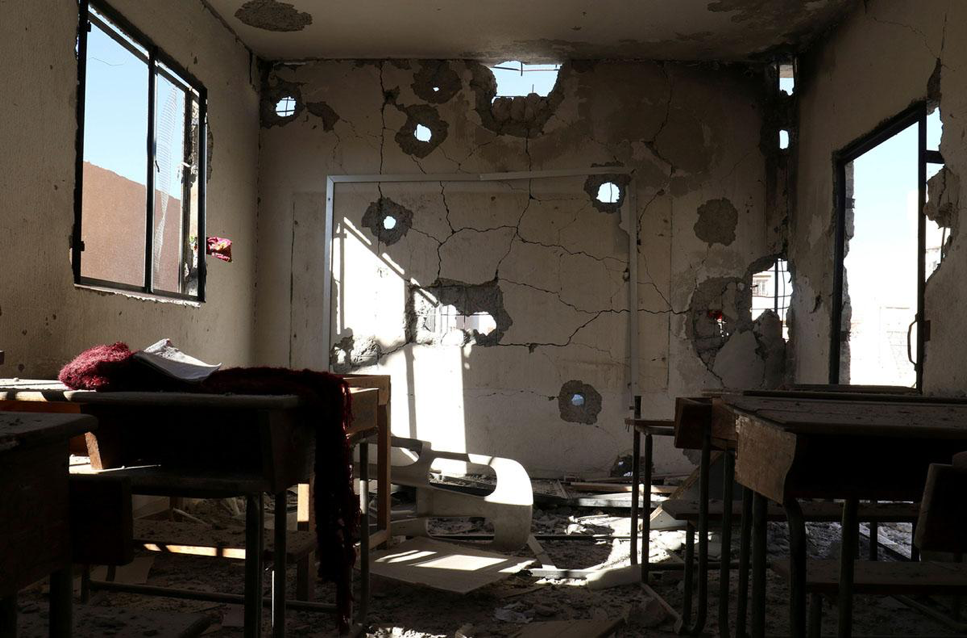
In the photo: A damaged classroom, after shelling in the rebel-held town of Hass, south of Idlib province, Syria, on October 26, 2016. Credit: Ammar Abdullah / Reuters
The story for the external diaspora is also disconcerting. Neighbouring countries to Syria have housed almost 5 million refugees whom have experienced varying obstacles to education. In Jordan, free access to vocational education for Syrian refugees was denied until late 2015, although the state did welcome Syrians into the mainstream public school system immediately. In Iraq, only five per cent of the Syrian refugee population aged 15-17 were enrolled in formal education. This is largely because the Syrian diaspora in Iraq is predominantly living in areas with limited access to secondary education, even before a refugee influx. Of course, Iraq’s own conflict crisis has caused extreme disruption to their own educational system.
The geographical issues surrounding the placement of Syrian refugees is not unique to Iraq – in Lebanon, most Syrians are housed in the already deprived areas of North and Bekaa regions; constituting a social discontent as well as an inaccessibility to facilities. Lebanon has the highest per capita refugee population in the world, and houses a considerable portion of the Syrian diaspora. In late 2013, the Ministry of Education and Higher Education in Lebanon with the support of the UNHRC began the second shift schooling system. The specialty afternoon classes for refugees assists students with French and English, two of the languages of instruction, to increase their prospects of entering mainstream schooling. The program ran in 330 schools in the 2016-17 educational year.
 In the photo: Syrian student and female teacher Credit: Zohra Bensemra / Reuters
In the photo: Syrian student and female teacher Credit: Zohra Bensemra / Reuters
The generosity of host countries in the Middle Eastern region is nothing short of remarkable, specifically considering the overstretched nature of the native institutions even before refugee intake. All three of the aforementioned hosting countries are not signatories to the 1951 Refugee Convention. Therefore, Jordan, Iraq, and Lebanon are not legally bound to support the Syrian refugees through this multilateral treaty that 145 other countries are signatories to. These neighbouring countries, amongst others, have made waves of difference from the ripples of a country in conflict.
Foreign donations will be crucial in helping Syria rebuild its education systems but there is a significant lack of transparency in foreign donations for Syrian education. The largest foreign donors, and imperative partners, to Syrian education are the European Union, the United States, Germany, United Kingdom, Norway, and Japan. The participants of the Support Syria London Conference in 2016 agreed that over a three-year period, Jordan needed US$1 billion for education of displaced Syrians. By the end of 2016, Jordan reported they received US$208.4 million, a shortfall of US$41.2 million from the pledged amount for the year – although the six donors report they donated US$279.2 million to education in Jordan in 2016. To assess the accountability to pledges Human Rights Watch has called for detailed, comprehensive, and transparent educational aid records. In an effort to optimise utility of resources in this ripe time for young Syrians, the integrity of foreign donations needs to be appraised.
 In the photo: In between class Credit: Amer Almohibany / AFP / Getty
In the photo: In between class Credit: Amer Almohibany / AFP / Getty
It must be recognised that foreign donations are only part of the picture. According to Human Rights Watch, foreign donations paid for 200,000 public school spaces for Syrian children in Lebanon. Only 149,000 enrolled. Access to transport presents a barrier to children receiving formal education, and so does cultural expectations of gender segregated classrooms that aren’t guaranteed in Lebanon. In Syria, most public schools are segregated by gender from age 12 onwards. In an initiative to be applauded, the Kayany Foundation has opened a school in Bar Elias in the Bekaa region of Lebanon, where most Syrian refugees are located. The school is for young girls aged 14-18 who have missed years of education, and even provides transport to and from school. The positive initiative by the Kayany foundation is the kind of specific investment in education young Syrians deserve. The school aptly addresses two of the barriers to education: gender and transport accessibility.
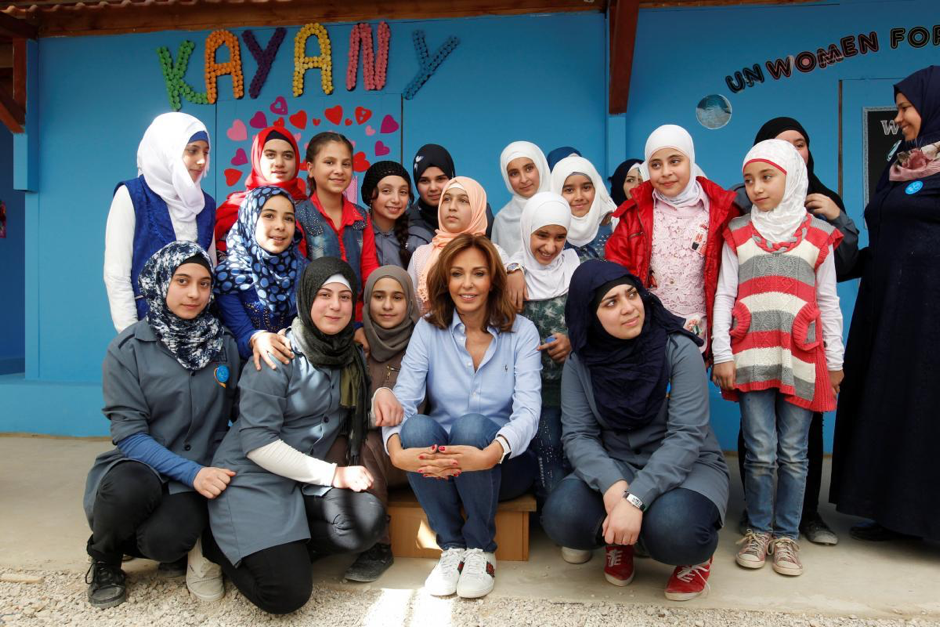
In the photo: Syrian refugee girls take a photo with Noura Jumblatt, founder of the NGO Kayany Foundation, at a school for Syrian refugee girls, built by the foundation in Bar Elias town, in the Bekaa valley, Lebanon October 19, 2017. Picture taken October 19, 2017. Credit: REUTERS/Aziz Taher
Education has a critical role to play in the reconstruction of Syria. The investment in the pillars of Positive Peace begins in the classroom. The acceptance of the rights of others and high levels of human capital, which ultimately leads to a sound economic environment and active civic participation, is fostered in the classroom. The pursuit of education in Syria for the last seven years has been dangerous, scattered, and for many people: simply inaccessible. The children and young adults denied of education now are the demographic that will be responsible for the way Syria is shaped in a post-conflict context.
The shift of Jabhat Fateh al-Sham’s terror tactics away from targeting educating facilities reported in the 2017 Global Terrorism Index is not only good news. It is also a timely call for robust investment, financially and otherwise, in the education of young Syrians. Syria, like most war-torn countries, has a disproportionately youthful population. If Syria is to have a chance at a society not only absent of conflict, but also characterised by investments in sustainable peace, the youth must be awarded the tools needed to build Syrian self-determination. Quality education will be the lectern from which this young demographic will share the voice of current and future Syria.
Editors note: The opinions expressed here by Impakter.com columnists are their own, not those of Impakter.com.


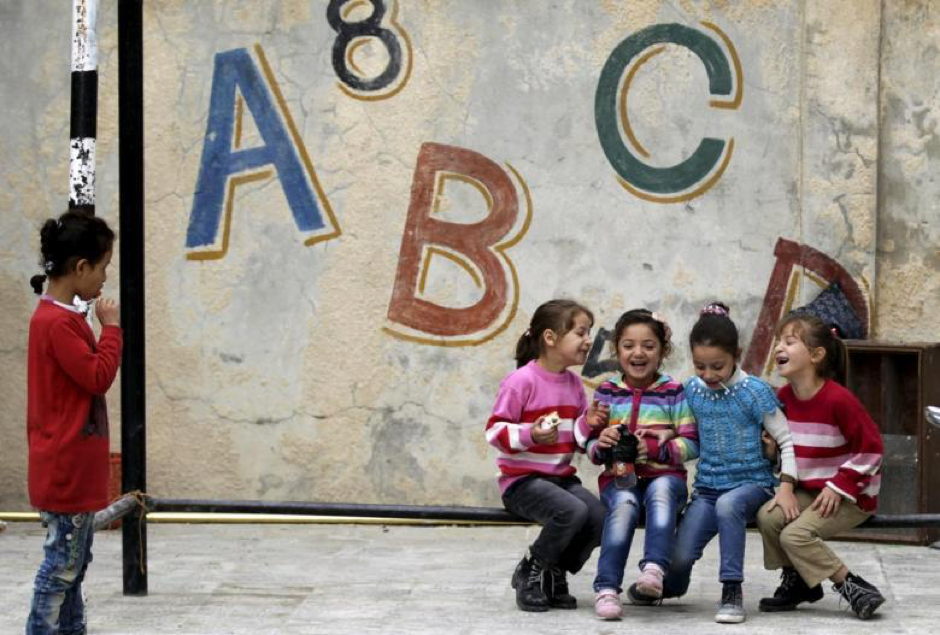 In the photo: Syrian children playing in the school playground Credit: REUTERS/ Khali Ashawi
In the photo: Syrian children playing in the school playground Credit: REUTERS/ Khali Ashawi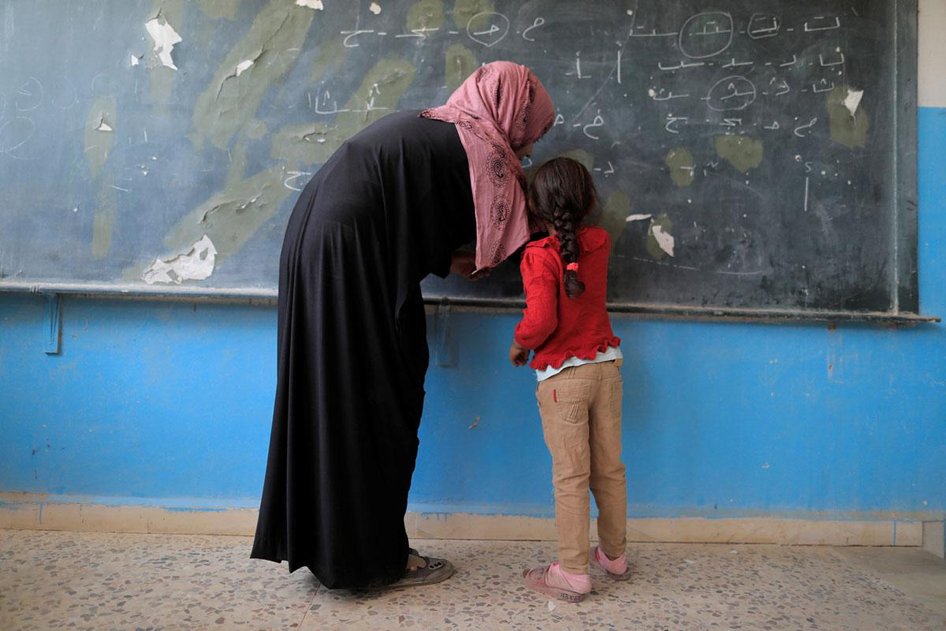
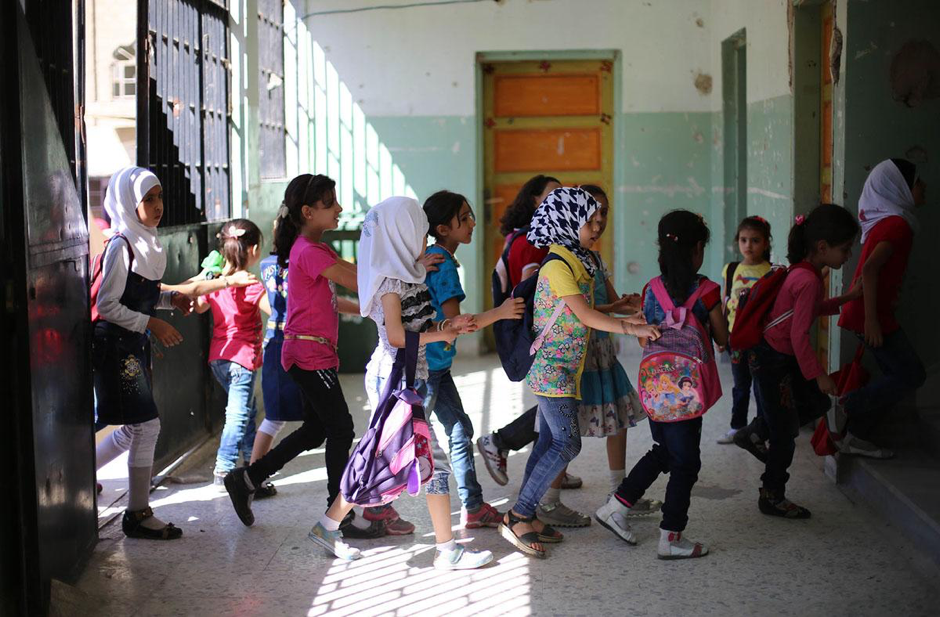 In the photo: In between class Credit:
In the photo: In between class Credit: 